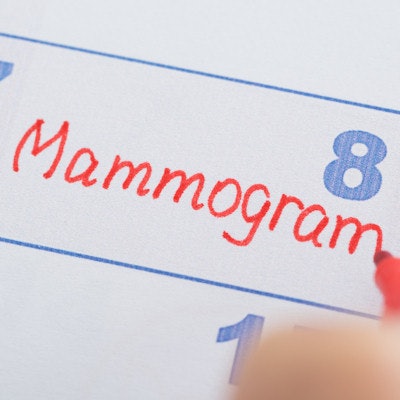
Regular breast cancer screening, particularly in younger women, translates to less-aggressive treatment when disease is discovered, according to research presented at the American Society of Breast Surgeons (ASBrS) annual meeting in Orlando, FL.
The results support a screening protocol that includes women between the ages of 40 and 49 -- an age group for whom screening is still controversial, said Dr. Elisa Port of Mount Sinai Hospital in New York City during a conference call hosted by the society on May 3.
"Women who have regular screening mammograms [i.e., within 24 months] present with smaller tumors and are less likely to be treated with mastectomy, chemotherapy, and axillary node dissection than those who do not," she said.
Suboptimal compliance
Port and colleagues evaluated the effect of screening mammography on breast cancer treatment, investigating specific benefits -- or lack thereof -- among particular age groups (40-49, 50-59, 60-69, and 70 and older). Their study included 1,125 women ages 40 and older who were treated for breast cancer between September 2008 and May 2016.
The researchers divided the women based on two time intervals: being screened within 24 months of cancer diagnosis, and being screened 25 months or more before diagnosis or having never been screened. They also assessed tumor size, lymph node status, whether mastectomy or axillary dissection had been performed, and whether the woman had received chemotherapy.
Of the total patient cohort, 73% underwent screening mammography within 24 months of breast cancer diagnosis, while 21% underwent screening 25 months or more before diagnosis and 6% had never been screened.
Overall, women with longer intervals between mammography screening exams were more likely to require invasive cancer treatment.
| Likelihood of cancer treatment by length of screening interval | ||||
| Cancer treatment | 1- to 24-month interval | ≥ 25-month interval | Odds ratio for cancer treatment | p-value |
| Chemotherapy | 33% | 42% | 1.51 | 0.004 |
| Mastectomy | 34% | 41% | 1.32 | 0.046 |
| Axillary dissection | 13% | 20% | 1.66 | 0.004 |
Among women ages 40 to 49, those who had never undergone mammography screening before cancer diagnosis had the following characteristics compared with those who had screening within 24 months of diagnosis:
- Larger tumors (mean of 23 mm versus 13 mm, p = 0.041)
- Higher likelihood of positive lymph nodes (odds ratio, 4.52; p = 0.005)
- Higher likelihood of mastectomy (odds ratio, 3.44; p = 0.006)
- Higher likelihood of axillary dissection (odds ratio, 4.64; p = 0.0002)
- Higher likelihood of chemotherapy (odds ratio, 2.52; p = 0.028)
The study shows that shorter screening intervals translate to less-invasive medical and surgical breast cancer treatment, particularly among younger women, Post said.
"Decision-making regarding screening mammography should not only take into account survival advantage but also other [factors], including the potential for less-aggressive treatment," she concluded.




















